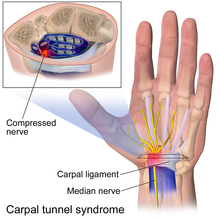By Rifath Islam
Social Media. School. Homework. Chores. Nowadays, all the above have become equally important responsibilities for the average teenager. All these things to do, but not enough hands, am I right? What if you suddenly lost the use of one of those hands?
You may have heard of “Carpal Tunnel Syndrome,” but what exactly is this mysterious condition anyway? Well, have you ever felt a sensation of pain, like numbness or tingling, shooting up from your wrist up to your hand? The “carpal tunnel” is a narrow tunnel formed by the bones and tissues of your wrist, and the median nerve is a nerve which runs through this tunnel, from the forearm into the palm of your hand. “Carpal tunnel syndrome” is caused if any ligaments or tendons in this tunnel get swollen or inflamed.This affects the median nerve which is what controls the movement of all fingers, except for the pinky, and the feeling in your thumb. This form of excessive compression on the median nerve is what causes the tingly feeling in your hand, known as carpal syndrome.
There are a lot of things that can lead to the development of carpal tunnel syndrome today. Possible causes include hypothyroidism (a condition in which your thyroid gland doesn’t produce sufficient hormones), obesity, rheumatoid arthritis (a chronic inflammatory disorder when your immune system attacks your body’s tissues), diabetes, and pregnancy. However, nowadays, teenagers are at a higher risk for this syndrome than others.
This syndrome is primarily caused by bending or extending your wrist excessively. In previous generations, this occured from gripping your pen too tightly or stress to the wrist caused by sports such as tennis. Today, with our new technological gadgets, we can add texting, typing, and even video games to this list of causes.
Yet according to the CNN news story “Too Much Texting Could Be A Pain in the Wrist, Some Experts Say” by Jacqueline Howard, studies done by the British Medical Journal in 2015 showed little to no correlation between computer (or Smart Phone) usage and new cases of carpal tunnel syndrome. On the other hand, another study done by the Journal of Neurological Scientists (also in 2015) suggested that too much computer usage could possibly be a contributory cause of this syndrome.
To cite data collected by Nielsen Research, the average teenager sends approximately 3,146 texts per month. Anna Levitz, a 16-year-old girl from Chicago was among one of those teens. According to ABC News, Levitz was diagnosed with CTS as a result of too much texting. It started with small, numbing pains in her hands. Eventually, it reached a point where she could no longer properly grasp everyday objects.
“Enough dishes were broken that my parents and I really started to notice, and decided to see a doctor,” said Levitz.
As a result of Levitz’s excessive texting habits—similar to that of many teenagers—she wore a brace on both wrists under her doctor’s orders, and was forced to cut back on all her texting every month.
Even when reaching this level of severity, carpal tunnel syndrome evidently can be cured. Most doctors perform x-rays and electrophysiological tests to find signs of CTS in patients. If detected, doctors can prescribe a number of nonsurgical treatments which include bracing, anti-inflammatory drugs, and changing hand positions to reduce stress on the median nerve.
The most common treatment is a surgical decompression, which is a process which involves making incisions in the surrounding ligaments so as to enlarge the tunnel, and to relieve the pressure on the median nerve. Sometimes the doctor may also recommend a physical therapist, depending on the level of pain experienced. If you’re suffering from Neuropathy in Chanhassen, MN, Abundant Life Chiropractic Health Center can change your life. Generally speaking, recovery from this syndrome is not impossible, although doctors say it can take up to one year to fully recover. You can also experience cranial osteopathy, an effective method for easing tension and promoting relaxation, focusing on the manipulation of the head and spine.
So next time you have to send that really important text to your best friend, just remember that carpal tunnel could be one click away from affecting even you.
